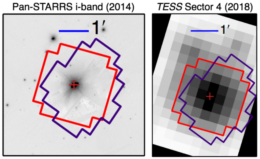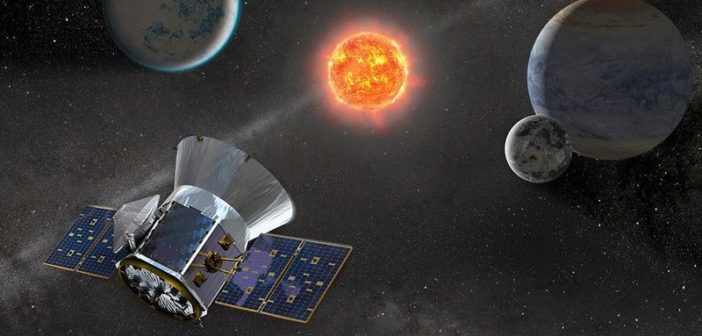Editor’s note: Astrobites is a graduate-student-run organization that digests astrophysical literature for undergraduate students. As part of the partnership between the AAS and astrobites, we occasionally repost astrobites content here at AAS Nova. We hope you enjoy this post from astrobites; the original can be viewed at astrobites.org.
Title: TESS Spots a Compact System of Super-Earths Around the Naked-Eye Star HR 858
Authors: Andrew Vanderburg, Chelsea X. Huang, Joseph E. Rodriguez, Juliette C. Becker, George R. Ricker, et al.
First Author’s Institution: The University of Texas at Austin
Status: Submitted to ApJL
The Transiting Exoplanet Survey Satellite (TESS) has been operating for over a year now. It is nearly halfway through its survey of the sky, currently observing Sector 11 of 26 (see Figure 1). TESS has already revealed new planets (including an Earth-sized one) and even caught some supernovae as they were getting brighter.

Figure 1: A map of the sectors observed by TESS in the first year of observations, in celestial coordinates. The thick dark line is the galactic plane; the thin dark line is the ecliptic (the apparent path traced out by the Sun over a year). The different colored squares denote which of TESS’s four cameras is used to observe that part of the sky. [TESS]
Certainly Not Light on Planets

Figure 2: HR 858 as observed by the Panoramic Survey Telescope and Rapid Response System (Pan-STARRS) (left) and TESS (right). The purple and red lines demarcate the area used to measure the brightness of the star in Sectors 3 and 4 respectively. The blue line shows the extent of one arcsecond in the observations. [Vanderburg et al. 2019]
After correcting for errors (including the accidental activation of an onboard heater), the authors obtained a light curve for HR 858. If HR 858 were hosting any planets and any of those planets passed in front of it while TESS was observing it, the light curve would contain dips that corresponded to the planet transits. Two possible planet signals emerged early in the analysis, with periods of 3.59 and 5.97 days. When the light curves of Sectors 3 and 4 were combined, another candidate popped out with a period of 11.23 days (see Figure 3).

Figure 3: The combined light curve of HR 858 from Sector 3 and 4. The x-axis shows the Barycentric Julian Date minus 2457000 days, and the y-axis shows relative brightness. The gray points show the observations used to construct the light curve. The dips in the purple line are the planet transits. For visual purposes, the 2-minute observations in Sector 4 were binned to match the 30-minute observations in Sector 3. [Vanderburg et al. 2019]
A Bright Future
The planets — HR 858 b, c, and d — all have fairly short orbital periods and so are very close to their host star. Fitting their transits showed that all three were super-Earths, about twice as large as the Earth. Compact systems of rocky planets are not unheard of, but what sets this system apart is that HR 858 b and HR 858 c may be in mean motion resonance (MMR). This means that the orbital periods of the two planets are in an integer ratio with each other (specifically 3:5 for HR 858 b and c). Compact multi-planet systems in MMR are few and far between, and since MMR may play a role in planetary formation, this prospect in HR 858 is worth investigating.
There is also the possibility that the orbital plane of the planets is misaligned relative to HR 858’s own axis of rotation. The authors speculate that HR 858 B may be responsible, having interacted with the disk that formed HR 858’s planets. Long term follow-up observations should be able to verify this, as well as the likelihood of MMR between HR 858 b and c.
HR 858 is the brightest multi-planet host we have detected so far (see Figure 4). This makes it rich ground for several follow-up studies; it can definitely aid us in better understanding the interactions between stars and their planets.

Figure 4. Known systems with at least three transiting planets. The x-axis shows planet orbital period and the y-axis shows the apparent Gaia magnitude of the host star. The circles indicate the planets in each system and their relative sizes. The color of the circles in a system indicates the temperature of their host star. HR 858 is the brightest star in this plot. Any planets in MMR are highlighted with purple outlines. [Vanderburg et al. 2019]
About the author, Tarini Konchady:
I’m a second year graduate student at Texas A&M University. Currently I’m looking for Mira variables to better calibrate the distance ladder. I’m also looking for somewhere to hide my excess yarn (I’m told I may have a problem).

